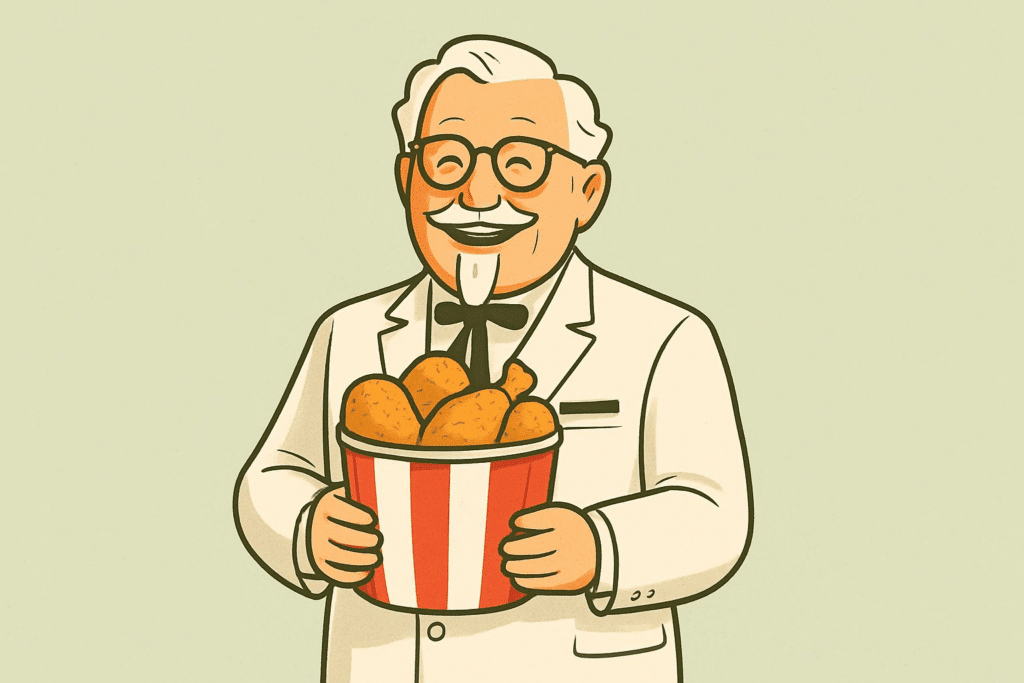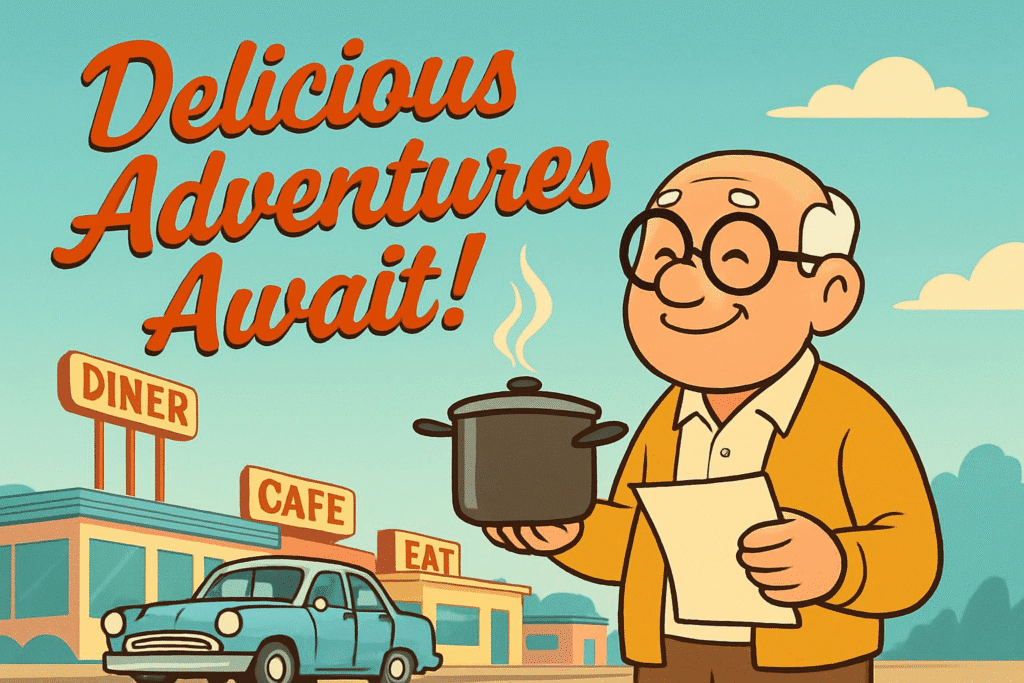Introduction

Most people slow down after 60.
Colonel Harland Sanders hit the gas.
He wasn’t born into success. He didn’t “make it” in his 30s. In fact, by the age of 62, Sanders had faced more failures than most people could stomach—failed jobs, bankrupt businesses, a life of instability.
But one thing he didn’t do? Quit.
Armed with a pressure cooker, a battered recipe notebook, and an obsession with flavor, this retired gas station owner began cooking chicken with a secret blend of 11 herbs and spices. Not in some corporate kitchen, but on the side of a dusty Kentucky highway.
He went door-to-door, pitching his chicken to strangers. Hundreds rejected him. Some laughed. But he kept going. Because real success? It doesn’t care about your age, past, or what the world thinks.
By 1964, he had licensed over 600 restaurants. KFC was no longer just chicken—it was a revolution. And Sanders, with his white suit and black string tie, became a walking icon of grit, flavor, and late-in-life triumph.
This isn’t just a rags-to-riches story.
It’s a masterclass in persistence, branding, and belief.
In this blog, we’ll dive deep into:
- The forgotten failures that shaped Sanders’ mindset
- The genius behind his chicken empire
- And the raw, real lessons every entrepreneur needs today
The Grit Before the Glory: Harland Sanders’ Early Life & Struggles

Before his face became iconic on buckets of fried chicken, Colonel Harland Sanders lived a life marked by hardship, hustle, and relentless reinvention. His success wasn’t born in a boardroom — it was carved out through decades of raw survival, painful failures, and unimaginable persistence.
A. Childhood Hardship & Hustle from the Start
Born on September 9, 1890, in the rural town of Henryville, Indiana, Sanders faced adversity before he ever learned to spell the word. At just six years old, tragedy struck — his father died, forcing his mother to work long hours in a tomato cannery to feed the family. With no choice but to grow up fast, young Harland took over the cooking and caregiving duties at home — skills that would, unknowingly, shape the future of fast food forever.
By seventh grade, Sanders dropped out of school. But this wasn’t an act of rebellion — it was survival. He started picking up whatever work he could find: farm laborer, streetcar conductor, railroad fireman, insurance salesman, and even a ferry boat operator. His résumé was more a record of survival than a ladder of success. He wore many hats, none of them glamorous — all of them necessary.
He didn’t just work; he tried to build. Sanders made attempts at entrepreneurship early on, running a gas station and later a small restaurant. But success stayed elusive. Time and again, he found himself broke, defeated, and starting over. Still, he never abandoned the belief that something bigger was waiting if he just kept moving.
B. Rock Bottom at 62 — And Then, a Spark
By most societal standards, age 62 is when people start slowing down. For Harland Sanders, it was the moment of absolute rock bottom. His once-promising restaurant — shuttered. His savings — gone. All he had was a $105 Social Security check and a homemade recipe for fried chicken that he believed in more than anything.
Instead of retiring quietly, he stuffed his car with pressure cookers, flour, spices, and faith — and hit the road. He went from diner to diner across America, offering restaurant owners a deal: “Use my recipe, and I’ll take a small cut per chicken sold.” More than 1,000 rejections followed. But Sanders wasn’t just peddling chicken — he was selling his unbreakable belief in second chances.
Turning Failure into Fuel
What set Sanders apart wasn’t luck or timing — it was his capacity to endure. Every closed door became fuel. Every “no” added flavor to the “yes” that would eventually lead to the birth of Kentucky Fried Chicken — a global brand that began not with venture capital, but with grit, grease, and a man who refused to quit.
Sanders’ story is a profound reminder: success doesn’t care about your age, your failures, or your past — it cares about your ability to keep going. In a world chasing shortcuts, Harland Sanders proved that sometimes, the longest road leads to the most unforgettable destination.
The Birth of Kentucky Fried Chicken: From Gas Station Cook to Global Icon

What separates a cook from a culinary legend? In the case of Colonel Harland Sanders, it was a secret blend of herbs, a pressure cooker, and the audacity to build a restaurant empire from the trunk of a car.
After decades of hardship, failures, and relentless trial-and-error, Sanders discovered something that would change not just his life — but the fast-food industry forever.
A. Crafting a Legend: The Secret Recipe & Roadside Kitchen
In 1939, after years of experimenting in his roadside diner in Corbin, Kentucky, Sanders perfected what would become the heart of his legacy: a proprietary blend of 11 herbs and spices, still cloaked in secrecy to this day. Unlike typical frying techniques that left chicken greasy and slow to cook, Sanders embraced pressure-cooking, a method that produced crispy, juicy chicken in record time — a revolutionary idea in an era before microwaves or deep fryers dominated kitchens.
His tiny gas station restaurant didn’t just serve food — it delivered an experience. Truckers and travelers passing through the rural highways of Kentucky began spreading word of the uniquely delicious fried chicken. It wasn’t just the flavor — it was the speed, consistency, and Sanders’ obsessive commitment to quality that turned passing customers into loyal fans.
In a world of diners serving the same tired menu, Sanders had stumbled upon a game-changer.
B. Franchising a Dream: From One Diner to Hundreds
By 1952, Sanders was 62 and nearly broke — but still unwilling to give up. That year, he approached a Utah restaurateur named Pete Harman with a bold idea: “Let me share my recipe. You use it, sell my chicken, and give me a small cut per sale.”
It worked — spectacularly.
Within months, Harman’s restaurant saw a dramatic rise in sales. Encouraged, Sanders hit the road once again — not to find a job, but to create opportunities. He crisscrossed the United States, cooking chicken in restaurant kitchens, giving live demos, and closing deals one handshake at a time.
By 1964, just 12 years after that first franchise, Kentucky Fried Chicken had exploded to over 600 locations — an unprecedented expansion at a time when franchising was still a novel concept. Sanders had transformed a simple kitchen innovation into a replicable business model that would soon circle the globe.
C. Selling the Empire, Staying the Soul
In 1964, Sanders made the difficult but strategic decision to sell Kentucky Fried Chicken for $2 million — a massive sum at the time. But this wasn’t the end of his journey; it was just a shift in role. While he no longer ran the business, Sanders stayed on as the face and heart of the brand.
With his iconic white suit, string tie, and unmistakable Southern charm, the Colonel became more than a logo — he became a living symbol of trust, quality, and down-home flavor. His likeness adorned billboards, commercials, and packaging, helping KFC become a household name across continents.
Even as the company grew beyond his control, Sanders remained a passionate advocate for the product and a relentless voice for preserving its quality.
From Obscurity to Icon
The rise of Kentucky Fried Chicken isn’t just a business case study — it’s a human story. It’s about how one man, armed with a pressure cooker and a dream, reshaped the way the world thinks about fast food. It’s about the power of persistence, innovation, and knowing that no failure is final if you still have fight left in you.
Today, KFC operates in more than 150 countries, serving millions every day. But it all began in a tiny gas station kitchen with a man who believed the right recipe could change everything.
Lessons from Colonel Sanders: What a 62-Year-Old Fried Chicken Salesman Can Teach You About Success

Most people expect their big break in their 20s or 30s. But Colonel Harland Sanders didn’t find his stride until most people would have already given up. From being flat broke at 62 to becoming the face of a global empire, his life is a crash course in how persistence, smart branding, and bold business thinking can create a legacy.
Here are four timeless lessons from the Colonel’s journey that every dreamer, hustler, and entrepreneur should live by.
A. Perseverance Isn’t Optional — It’s the Path
Sanders didn’t just fail — he failed repeatedly, across multiple industries. He was fired from jobs, rejected by over 1,000 restaurant owners, and faced bankruptcy more than once. But quitting was never part of his vocabulary.
Most people would see age 62 as a time to slow down. Sanders saw it as his starting line.
His life redefines what “too late” means. It reminds us that persistence isn’t just admirable — it’s often the only thing that separates success from obscurity. Your timeline doesn’t have to look like anyone else’s. What matters is that you keep showing up.
B. Personal Branding: Be the Face Before You Sell the Product
Sanders didn’t just sell chicken — he sold trust, heritage, and a story. The iconic white suit, black string tie, cane, and goatee weren’t just eccentric fashion choices — they were strategic branding tools. He understood that in a crowded marketplace, authenticity is magnetic.
He made himself a living logo — and it worked. Long before influencers were a thing, Harland Sanders proved that people don’t just buy products; they buy into personalities. His image turned KFC from a meal into a movement.
For anyone building a brand today, the takeaway is simple: Be unforgettable — or be overlooked.
C. Scale Smart: The Power of Franchising
Sanders didn’t try to open hundreds of restaurants himself — he franchised his way to the top. Instead of controlling every location, he licensed his recipe and let other entrepreneurs grow the empire with him.
This approach allowed KFC to scale faster than most could imagine, turning a local recipe into a global phenomenon.
Sanders wasn’t just a great cook — he was a systems thinker. He didn’t just create a product; he created a replicable business model. Franchising wasn’t common at the time, but he saw its potential before most others. That foresight helped turn Kentucky Fried Chicken into one of the most successful fast-food chains in history.
D. Failures Aren’t Final — They’re Raw Ingredients
Sanders didn’t treat failure as an endpoint. He treated it like feedback.
Every lost job, every closed restaurant, every “no” from a potential franchisee taught him something. He learned to pivot, adapt, and refine. His resilience wasn’t accidental — it was practiced.
Too often, we see failure as a signal to stop. But for Sanders, each misstep was just a detour. He teaches us that setbacks aren’t signs of weakness — they’re signs that you’re still trying. And sometimes, trying is the most courageous thing you can do.
Colonel Sanders’ legacy isn’t just about fried chicken. It’s about a mindset — the belief that it’s never too late, you’re never too old, and no failure is too big to come back from.
His story continues to inspire millions not because of what he sold, but because of how he lived — with vision, grit, and an unshakeable belief that success was still ahead of him.
So whether you’re 25 or 65, still dreaming or rebuilding, remember this: your breakthrough might just be one more failure away. Keep going.
Recommended Reads: Discover the Man Behind the Bucket
If Colonel Harland Sanders’ story lit a spark in you — whether as an entrepreneur, late bloomer, or simply someone curious about how passion and grit can shape history — these hand-picked books will take you deeper into his life, mindset, and legacy. Each one offers a unique perspective on how a man with nothing but a pressure cooker and persistence changed the way the world eats.
1. Colonel Sanders and the American Dream by Josh Ozersky
📖 Why It’s Worth Reading:
This book isn’t just a biography — it’s a cultural exploration of how Sanders’ rise to fame mirrors the American dream itself. Historian and food writer Josh Ozersky gives readers an unfiltered look at how Sanders built an empire without polishing the rough edges of his life.
🔗 Available on Amazon India: Click here
Conclusion: Legacy of a Legend — What Colonel Sanders Really Taught Us
Colonel Harland Sanders wasn’t born into wealth. He didn’t have a formal education, a marketing degree, or a tech startup. What he did have was unshakable grit, an unwavering belief in his recipe, and the courage to start from scratch — at an age when most people are planning for retirement.
His journey from living off a $105 Social Security check to becoming the face of a global fast-food empire is more than just a business story — it’s a blueprint for how persistence, self-belief, and clever branding can rewrite even the most unlikely narrative.
Here’s what we should take with us:
✅ There’s no expiration date on dreams
At 62, Sanders didn’t slow down — he sped up. If you’re breathing, it’s not too late to build something extraordinary.
✅ Resilience is more powerful than talent
You can lose jobs, money, and opportunities — but if you refuse to lose hope, you’re still in the game.
✅ Your story is your brand
Sanders didn’t hide his identity — he turned it into an icon. When you show up as yourself, people remember you.
✅ Smart scaling beats working harder
One restaurant would’ve been enough for many, but Sanders thought bigger. Through franchising, he multiplied his vision — and his impact.
His legacy isn’t just crispy chicken and iconic branding — it’s the reminder that even in the face of relentless failure, you can still rise.
🔥 So, if you’re standing at a crossroads, doubting whether it’s too late to chase your goals — remember the man in the white suit who turned rejection into recognition, and pressure cooking into a global empire
FAQ’s
Did Colonel Sanders really launch KFC at the age of 62?
Yes — and it’s not a myth.
Harland Sanders was 62 years old, living off a modest $105 monthly Social Security check, when he decided to turn his fried chicken recipe into a business opportunity. Instead of retiring, he hit the road — pitching his concept door-to-door to restaurant owners.
How many times did Sanders get rejected before he succeeded?
Over 1,000 times. Seriously.
Most people give up after a handful of rejections. Not Sanders. He was turned down more than 1,000 times before finally landing his first franchise deal. His story is the definition of relentless determination.
Why did Colonel Sanders sell KFC after finally finding success?
Because scaling a global empire is no small task.
In 1964, as the company grew at an overwhelming pace, Sanders sold KFC for $2 million. He admitted he no longer had the energy or resources to manage its explosive expansion — but he remained the brand’s public face and spirit.
What was his net worth when he died?
Millions — though far less than KFC’s eventual value.
Despite selling the company early, Sanders secured a lifetime salary, remained a brand ambassador, and earned well through other ventures. When he passed away in 1980, his net worth was in the millions, though KFC would go on to be worth billions.
What is Colonel Sanders’ legacy today?
A global icon in food and branding.
KFC is now one of the largest fast-food chains in the world, with 20,000+ outlets across 118 countries. More than just a logo, Colonel Sanders remains a symbol of resilience, reinvention, and entrepreneurial courage.
